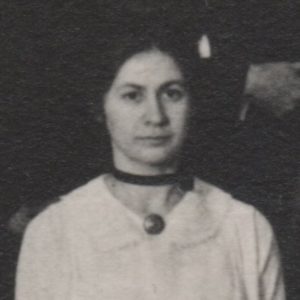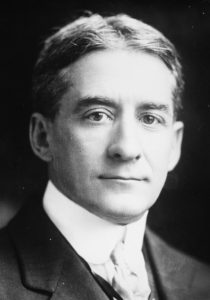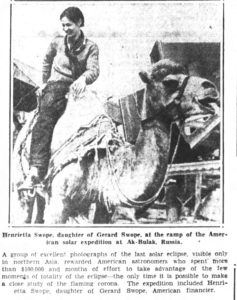
When I wrote last time on the “The Other Worldly Orbit of Jane Addams,” I knew I was going to follow it up by writing the story of a particular Hull-House resident, the daughter of Hull-House residents, who became an astronomer and very early in her career discovered 385 stars. This story of a woman named Henrietta Swope began at Hull-House, where her settlement worker parents met. It passed back through Hull-House with her own year of residency at the settlement after her graduation from Barnard College in 1925. And it is as illustrative of the extraordinary list of human beings who had a connection to Jane Addams and to Hull-House as the variable stars Swope studied are of the beauty of the universe.
Henrietta Swope began dreaming about the stars when she was ten years old, and I cannot help but think that at least a little part of the reason she was able to reach those stars was because she had Hull-House in her family.
But more about the stars later. Let’s start Henrietta’s story at the very beginning.
On Tuesday, August 20, 1901, at noon, in a clearing in the woods on Mackinac Island in northern Michigan, Jane Addams delivered a wedding speech. It was an unusual venue for the settlement leader to give a speech. But it was an unusual wedding. It was the union of Hull-House residents Mary Hill and Gerard Swope, two young members of the extended Hull-House family. A large contingent of the small wedding party were Hull-House residents, including the bride and groom’s best friends George Hooker and Maud Gernon.
Addressing the couple and the wedding party near picturesque Sugar Loaf Rock, Addams said, in part:
“Knowing as we do something of the character of these two people, somewhat of the temper of their attachment and the form of the expression we may confidently predict that and all life’s journey through to the end is will be illuminated by [that] Love which carries a burden which is no burden, the Love which attempts what is above its strength, pleads no excuse of impossibility for it believes all things are possible to itself.”
It’s a coincidence and not at all prophetic, but I love that Addams used the word “illuminated” and wow, indeed, “all things are possible.”
Mary Hill and Gerard Swope were two extraordinary young people who found their way to Hull-House and who would be forever shaped by the experience. Mary was the thirty-year-old the daughter of a former Harvard president and an 1896 graduate of Bryn Mawr College. She moved to Chicago to study at the University of Chicago under renown educator John Dewey. In 1898, she became a resident at Hull-House, where she taught textile classes and basket weaving, directed the Hull-House Shakespeare Club, and for a time managed the Hull-House Labor Museum. The twenty-eight-year-old Gerard Swope, a native of St. Louis, arrived in Chicago with a degree in electrical engineering from the Massachusetts Institute of Technology. He worked at the Western Electric Company in Chicago, and he taught English, electronics, and algebra classes at Hull-House and lived at the settlement for a short time in 1897. Mary and Gerard met at the settlement and fell in love.

Gerard moved to St. Louis in 1899 to become a branch manager there for Western Electric, and Mary remained at Hull-House. The couple maintained a long-distance relationship until their wedding, after which Mary joined her new husband in St. Louis, where she did social welfare work and the couple started their family. Their first child Henrietta was born in St. Louis on October 26, 1902. Three sons—Isaac, David, and Gerard Jr.—followed, and a fourth son John was born in New Jersey where Gerard Sr. moved the family as his career path led him to the East Coast. In 1919, Gerard became president of General Electric’s new subsidiary International G.E., and the family moved to Manhattan. Gerard was involved with various reform organizations and he worked for quality working conditions which set him apart in the 1920s from many of his contemporary leaders of large corporations. Mary became a member of the board of directors of the Henry Street Settlement, operated by Lillian Wald, the good friend of Jane Addams, and she volunteered at Greenwich House and served as vice-chair of the New York branch of the Women’s International League for Peace and Freedom.
Over the years, Mary and Gerard Swope kept in touch with Jane Addams, visited Hull-House, and made donations to the settlement. Gerard became a millionaire and in 1922 became the president of General Electric. The Swopes sent their bright daughter Henrietta off to Barnard College, where she earned her degree in mathematics; and then they sent her off to Chicago. Or perhaps Henrietta herself felt the pull of social work and felt the family connection to Hull-House. Although little is known about Henrietta’s time in that city, she lived at the settlement and worked in a program for the elderly while studying in the School of Social Service Administration (formerly the School of Civics and Philanthropy) at the University of Chicago with two significant members of Jane Addams’s orbit, Sophonisba Breckinridge and Edith Abbott.
But Henrietta Swope was still dreaming of the stars.
 So she left Chicago to take a job at Harvard to work for the astronomy professor Dr. Harlow Shapley at the Harvard Observatory. While she looked for variable stars and became Shapley’s first assistant, she earned a Master’s degree in astronomy from Radcliffe College in 1928. The following year, she became famous when she identified 385 new stars, which helped scientists identify the “hub” of the Milky Way. At the time, Swope was touted as “one of the youngest women ever to have made a comparable mark in scientific research.” During her long, successful career as an astronomer, she studied Cepheid variable stars in dwarf galaxies and M 31, the Andromeda Galaxy. However, her most significant contribution was developing a new method for measuring the universe, using the brightness of stars, which became known as the “celestial yardstick.” I don’t understand any of this, but it sounds amazing. Henrietta Swope was an accomplished and well-respected scientist.
So she left Chicago to take a job at Harvard to work for the astronomy professor Dr. Harlow Shapley at the Harvard Observatory. While she looked for variable stars and became Shapley’s first assistant, she earned a Master’s degree in astronomy from Radcliffe College in 1928. The following year, she became famous when she identified 385 new stars, which helped scientists identify the “hub” of the Milky Way. At the time, Swope was touted as “one of the youngest women ever to have made a comparable mark in scientific research.” During her long, successful career as an astronomer, she studied Cepheid variable stars in dwarf galaxies and M 31, the Andromeda Galaxy. However, her most significant contribution was developing a new method for measuring the universe, using the brightness of stars, which became known as the “celestial yardstick.” I don’t understand any of this, but it sounds amazing. Henrietta Swope was an accomplished and well-respected scientist.
In 1936, Henrietta Swope was a member of the joint-expedition of the Harvard Observatory and the Massachusetts Institute of Technology to study the solar eclipse in Soviet Central Asia. During World War II, she worked in the M.I.T. Radiation Laboratory and then served as a mathematician in the Hydrographic Office of the United States Department of the Navy. Swope returned to Barnard College in 1947 to teach astronomy until 1952, when she moved to California to work at the Mt. Wilson and Palomar Observatories. After her retirement in 1968, she continued to work at the observatories. Swope was a member of the American Astronomical Society; she won the American Astronomical Society Annie Jump Cannon Prize in 1968 for her research on photometry and variable stars; and she received an honorary Ph.D. from the University of Basel in Switzerland.
Henrietta Swope dreamed of the stars, she reached the stars, and then she made certain many generations to come could see the stars. In 1969, when she was in active retirement, Swope donated $650,000 worth of securities to the Carnegie Institution of Washington for the development of the Las Campanas Observatory in Chile and the installation of a 40-inch telescope in the mountains. The Swope Telescope began operation in 1971. Henrietta Swope died in 1980, but the observatory she helped established is still helping people look at the stars.
Now, how’s that for a life story from the otherworldly orbit of Jane Addams?
By Stacy Lynn,
Associate Editor
Sources: “Swope, Gerard,” American National Biography; Mary Hill Swope Papers, Finding Aid, Special Collections, University of Illinois Chicago; Papers of Henrietta Hill Swope, Schlesinger Library, Radcliffe Institute, Harvard University; Oral History of Henrietta Swope, August 1977, Transcript, Niels Bohr Library and Archives, American Institute of Physics, College Park, MD; Carnegie Institution of Washington, Year Book 67, 1967-1868, 73-74; “Hull House Teacher is Wed,” Chicago Tribune, Aug. 21, 1901, p. 3; “Romantic Wedding,” The Daily Herald (Port Huron, MI), Aug. 21, 1901, p. 5; “Wealthy Girl Aids in Finding Universe’s Hub,” The Capital Times (Madison, WI), June 11, 1929, p. 6 (image 1); “Girl Aids in Discovering Hub of Universe,” The Rock Island (IL) Argus, June 13, 1929, p. 12; “Henrietta Swope Wins Distinction,” The North Addams (MA) Transcript, June 24, 1929, p. 8; “Girl in Her Twenties Gets Credit in Major Scientific Discovery,” The Dispatch (Moline, IL), July 26, 1929, p. 31; “Girl Eclipses Stay-at-Homes,” Journal Gazette (Mattoon, IL), July 6, 1936, p. 6 (image 2); “Henrietta H. Swope, Is Dead; Helped to Measure Variable Stars,” The New York Times, Nov. 28, 1980, p. 28; “Studies Gauged Depths of Space,” The Los Angeles Times, Dec. 1, 1980, p. 23; Hull-House Bulletin, 3 (Oct. 1898), 7, Jane Addams Papers Microfilm Edition (JAPM), 53:1051; Hull-House Bulletin, 3 (Nov. 1898), 4, JAPM, 53:1058; Hull-House Bulletin, 4 (Autumn 1900), 3, 4, JAPM, 53:1106-1107; Selected Papers of Jane Addams, 3:618n5; Jane Addams to Florence Kelley, August 1, 1901; Address at the wedding of Gerard Swope and Mary Dayton Hill, August 21, 1901; Jane Addams to Esther Linn Hulbert, July 16, 1901; Gerard Swope to Jane Addams, January 7, 1905; Mary Hill Swope to Jane Addams, December, 1910; Gerard Swope to Jane Addams and Mary Rozet Smith, January 19, 1923, all in Jane Addams Digital Edition.
A scholarly editor and historian, Stacy Lynn formerly edited the papers of Abraham Lincoln and currently is an editor at the Jane Addams Papers Project.


